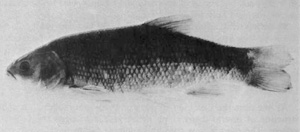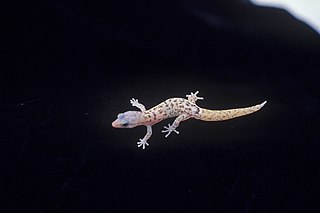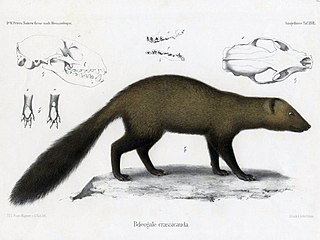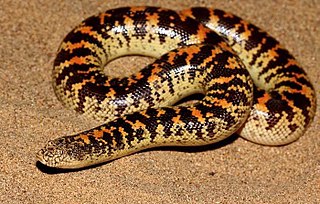
Bunopus is a genus of small geckos, lizards in the family Gekkonidae. The genus is endemic to the Middle East.

Gekkoninae is a diverse subfamily of the family Gekkonidae, geckos. It has the most species and genera — over 850 species in 30 genera. Hemidactylus and Cyrtodactylus together account for 185 species.

Tarentola mauritanica, known as the common wall gecko, is a species of gecko (Gekkota) native to the western Mediterranean area of North Africa and Europe. It has been introduced to Madeira and Balearic Islands, and the Americas. A nocturnal animal with a predominantly insectivorous diet, it is commonly observed on walls in urban environments in warm coastal areas; it can be found further inland, especially in Spain where it has a tradition of cohabitation with humans as an insect hunter. A robust species, up to 15 centimetres (5.9 in) long, its tubercules are enlarged and give the species a spiny armoured appearance.

The thicktail chub was a type of minnow that inhabited the lowlands and weedy backwaters of the Sacramento and San Joaquin Rivers in the Central Valley of California. It was once abundant in lowland lakes, marshes, ponds, slow-moving stretches of river, and, during years of heavy run-off, the surface waters of San Francisco Bay. The thicktail chub was one of the most common fish in California. Within Native American middens it represented 40% of the fish.

The Monito gecko is a lizard, a species of gecko endemic to the island of Monito, in the archipelago of Puerto Rico.

Bdeogale is a mongoose genus that was proposed by Wilhelm Peters in 1850 based on a mongoose specimen collected in Mozambique. Bdeogale species have compact paws with four symmetrical toes, round ears and a blunt muzzle with a broad round and bare rhinarium. The genus contains four species that are primarily terrestrial and omnivorous and forage in dense vegetation.

The bushy-tailed mongoose is a mammal in the family Herpestidae found in central Africa, from southern Kenya to central Mozambique.

The gecko catshark is a species of catshark, part of the family Scyliorhinidae, native to the northwestern Pacific Ocean from southern Japan to Taiwan, and possibly also off Vietnam. It is a common, demersal species found at depths of 100–900 m (330–2,950 ft). Its body is slender, with a pattern of dark saddles and blotches. The dorsal and caudal fins are edged in white, and there is a prominent crest of enlarged dermal denticles along the dorsal edge of the caudal fin. The gecko catshark is a schooling, opportunistic predator of bony fishes, cephalopods, and crustaceans. It is oviparous, with females producing two vase-shaped egg capsules at a time. This species is captured as bycatch, but does not appear to be threatened by fishery activities at present and has been assessed as Least Concern by the International Union for Conservation of Nature (IUCN).

The thick-tailed pygmy jerboa is a species of rodent in the family Dipodidae. It is found in China, Kazakhstan, and Mongolia. Its natural habitats are temperate grassland and temperate desert. It is threatened by habitat loss. It is listed by the IUCN as being "least concern".

Lygodactylus williamsi is a critically endangered species of lizard in the family Gekkonidae. The species is endemic to a small area of Tanzania. Common names include turquoise dwarf gecko, William's dwarf gecko, and, in the pet trade, electric blue gecko.

Eryx jayakari, known commonly as the Arabian sand boa or Jayakar's sand boa, is a species of snake in the family Boidae. The species is endemic to the Arabian Peninsula and Iran where it spends the day buried in the sand.
Nephrurus stellatus, also known as the stellate knob-tailed gecko, starry knob-tailed gecko, or southern knob-tailed gecko, is a species of gecko in the family Carphodactylidae. It is endemic to southern Australia.
Hoburogekko is an extinct genus of gecko that includes a single species, Hoburogekko suchanovi, from the Early Cretaceous of Mongolia. It is known from two fossil specimens, one preserving the front part of the skull and the other preserving part of the lower jaw. Hoburogekko is one of four known Mesozoic geckos or gecko-like lizards, the others being Cretaceogekko from the Early Cretaceous of Burma, AMNH FR21444, an undescribed specimen from a slightly older deposit in Mongolia, and Gobekko from the Late Cretaceous of Mongolia. Hoburogekko is the third oldest known gecko behind AMNH FR21444 and Cretaceogekko.

Gekko gigante, also known as the Gigante narrow-disked gecko or the Gigante gecko, is a species of gecko found in the Gigantes Islands in Carles, Iloilo Philippines.
Bunopus blanfordii, also known commonly as Blanford's ground gecko and Blanford's rock gecko, is a species of lizard in the family Gekkonidae. The species is native to Western Asia.

Bunopus tuberculatus, also known as the Baluch rock gecko, Arabian desert gecko, or southern tuberculated gecko is a species of gecko found in the Middle East.

Cyrtodactylus annulatus, also known as the annulated bow-fingered gecko or small bent-toed gecko, is a species of gecko endemic to the Philippines.

Microgecko persicus, known as the Persia sand gecko or Persian dwarf gecko, is a species of lizard in the family Gekkonidae. The species is endemic to Iran, Iraq and Pakistan. As of January 2019 its conservation status has not been assessed on the IUCN Red List.
Pristurus insignis, also known as Blanford's rock gecko, is a species of lizard in the Sphaerodactylidae family found on Socotra Island.

The Cape York mulch-skink is a species of skink found in Queensland in Australia.

















